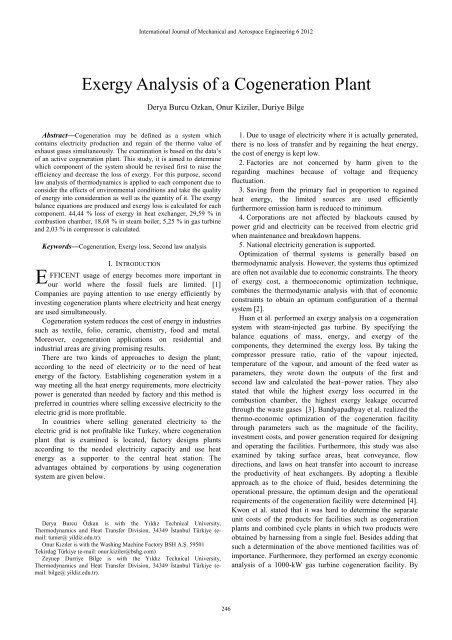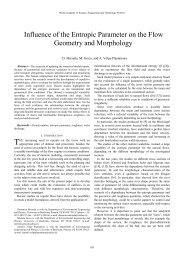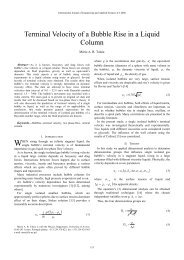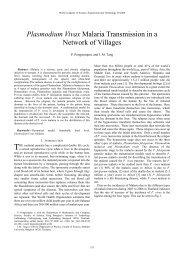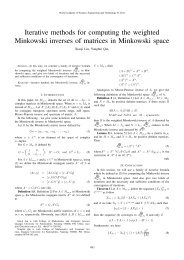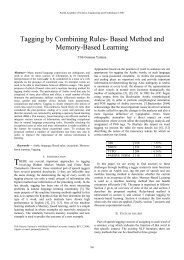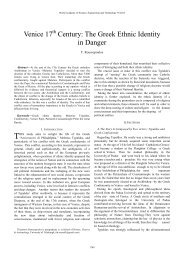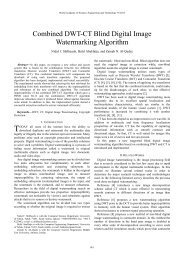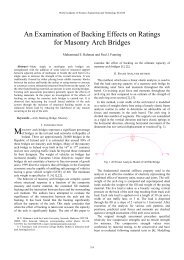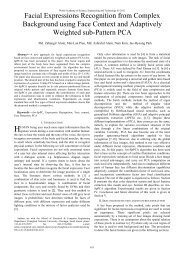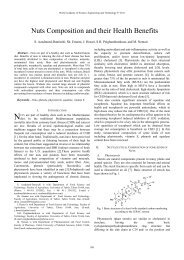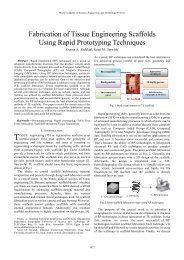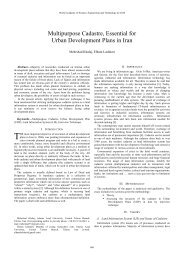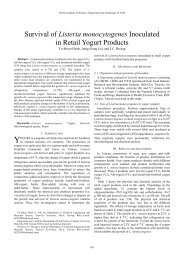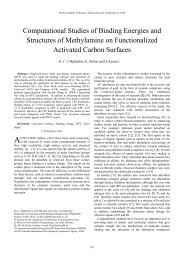Exergy Analysis of a Cogeneration Plant - World Academy of ...
Exergy Analysis of a Cogeneration Plant - World Academy of ...
Exergy Analysis of a Cogeneration Plant - World Academy of ...
Create successful ePaper yourself
Turn your PDF publications into a flip-book with our unique Google optimized e-Paper software.
Abstract—<strong>Cogeneration</strong> may be defined as a system which<br />
contains electricity production and regain <strong>of</strong> the thermo value <strong>of</strong><br />
exhaust gases simultaneously. The examination is based on the data’s<br />
<strong>of</strong> an active cogeneration plant. This study, it is aimed to determine<br />
which component <strong>of</strong> the system should be revised first to raise the<br />
efficiency and decrease the loss <strong>of</strong> exergy. For this purpose, second<br />
law analysis <strong>of</strong> thermodynamics is applied to each component due to<br />
consider the effects <strong>of</strong> environmental conditions and take the quality<br />
<strong>of</strong> energy into consideration as well as the quantity <strong>of</strong> it. The exergy<br />
balance equations are produced and exergy loss is calculated for each<br />
component. 44,44 % loss <strong>of</strong> exergy in heat exchanger, 29,59 % in<br />
combustion chamber, 18,68 % in steam boiler, 5,25 % in gas turbine<br />
and 2,03 % in compressor is calculated.<br />
E<br />
Keywords—<strong>Cogeneration</strong>, <strong>Exergy</strong> loss, Second law analysis<br />
I. INTRODUCTION<br />
FFICENT usage <strong>of</strong> energy becomes more important in<br />
our world where the fossil fuels are limited. [1]<br />
Companies are paying attention to use energy efficiently by<br />
investing cogeneration plants where electricity and heat energy<br />
are used simultaneously.<br />
<strong>Cogeneration</strong> system reduces the cost <strong>of</strong> energy in industries<br />
such as textile, folio, ceramic, chemistry, food and metal.<br />
Moreover, cogeneration applications on residential and<br />
industrial areas are giving promising results.<br />
There are two kinds <strong>of</strong> approaches to design the plant;<br />
according to the need <strong>of</strong> electricity or to the need <strong>of</strong> heat<br />
energy <strong>of</strong> the factory. Establishing cogeneration system in a<br />
way meeting all the heat energy requirements, more electricity<br />
power is generated than needed by factory and this method is<br />
preferred in countries where selling excessive electricity to the<br />
electric grid is more pr<strong>of</strong>itable.<br />
In countries where selling generated electricity to the<br />
electric grid is not pr<strong>of</strong>itable like Turkey, where cogeneration<br />
plant that is examined is located, factory designs plants<br />
according to the needed electricity capacity and use heat<br />
energy as a supporter to the central heat station. The<br />
advantages obtained by corporations by using cogeneration<br />
system are given below.<br />
Derya Burcu Özkan is with the Yıldız Technical University,<br />
Thermodynamics and Heat Transfer Division, 34349 İstanbul Türkiye (email:<br />
tumer@ yildiz.edu.tr).<br />
Onur Kızıler is with the Washing Machine Factory BSH A.Ş. 59501<br />
Tekirdağ Türkiye (e-mail: onur.kiziler@bshg.com)<br />
Zeynep Durriye Bilge is with the Yıldız Technical University,<br />
Thermodynamics and Heat Transfer Division, 34349 İstanbul Türkiye (email:<br />
bilge@ yildiz.edu.tr).<br />
International Journal <strong>of</strong> Mechanical and Aerospace Engineering 6 2012<br />
<strong>Exergy</strong> <strong>Analysis</strong> <strong>of</strong> a <strong>Cogeneration</strong> <strong>Plant</strong><br />
Derya Burcu Ozkan, Onur Kiziler, Duriye Bilge<br />
246<br />
1. Due to usage <strong>of</strong> electricity where it is actually generated,<br />
there is no loss <strong>of</strong> transfer and by regaining the heat energy,<br />
the cost <strong>of</strong> energy is kept low.<br />
2. Factories are not concerned by harm given to the<br />
regarding machines because <strong>of</strong> voltage and frequency<br />
fluctuation.<br />
3. Saving from the primary fuel in proportion to regained<br />
heat energy, the limited sources are used efficiently<br />
furthermore emission harm is reduced to minimum.<br />
4. Corporations are not affected by blackouts caused by<br />
power grid and electricity can be received from electric grid<br />
when maintenance and breakdown happens.<br />
5. National electricity generation is supported.<br />
Optimization <strong>of</strong> thermal systems is generally based on<br />
thermodynamic analysis. However, the systems thus optimized<br />
are <strong>of</strong>ten not available due to economic constraints. The theory<br />
<strong>of</strong> exergy cost, a thermoeconomic optimization technique,<br />
combines the thermodynamic analysis with that <strong>of</strong> economic<br />
constraints to obtain an optimum configuration <strong>of</strong> a thermal<br />
system [2].<br />
Huan et al. performed an exergy analysis on a cogeneration<br />
system with steam-injected gas turbine. By specifying the<br />
balance equations <strong>of</strong> mass, energy, and exergy <strong>of</strong> the<br />
components, they determined the exergy loss. By taking the<br />
compressor pressure ratio, ratio <strong>of</strong> the vapour injected,<br />
temperature <strong>of</strong> the vapour, and amount <strong>of</strong> the feed water as<br />
parameters, they wrote down the outputs <strong>of</strong> the first and<br />
second law and calculated the heat–power ratios. They also<br />
stated that while the highest exergy loss occurred in the<br />
combustion chamber, the highest exergy leakage occurred<br />
through the waste gases [3]. Bandyapadhyay et al. realized the<br />
thermo-economic optimization <strong>of</strong> the cogeneration facility<br />
through parameters such as the magnitude <strong>of</strong> the facility,<br />
investment costs, and power generation required for designing<br />
and operating the facilities. Furthermore, this study was also<br />
examined by taking surface areas, heat conveyance, flow<br />
directions, and laws on heat transfer into account to increase<br />
the productivity <strong>of</strong> heat exchangers. By adopting a flexible<br />
approach as to the choice <strong>of</strong> fluid, besides determining the<br />
operational pressure, the optimum design and the operational<br />
requirements <strong>of</strong> the cogeneration facility were determined [4].<br />
Kwon et al. stated that it was hard to determine the separate<br />
unit costs <strong>of</strong> the products for facilities such as cogeneration<br />
plants and combined cycle plants in which two products were<br />
obtained by harnessing from a single fuel. Besides adding that<br />
such a determination <strong>of</strong> the above mentioned facilities was <strong>of</strong><br />
importance. Furthermore, they performed an exergy economic<br />
analysis <strong>of</strong> a 1000-kW gas turbine cogeneration facility. By
calculating the exergy costs for a unit product, they wrote<br />
down the exergy balance for each point during the flow<br />
process and they formed an exergy economic balance equation<br />
for each component based on these exergy values. They<br />
employed a specific energy cost method developed by<br />
Tsatsaronis and the method <strong>of</strong> Modified Productive Structure<br />
<strong>Analysis</strong> <strong>of</strong> Thermal System developed by Kim and later<br />
compared the cost <strong>of</strong> the products. According to the result <strong>of</strong><br />
the study mentioned above, when the specific exergy cost<br />
method was analyzed, although employing a waste heat boiler<br />
did not cause a change in the exergy cost <strong>of</strong> unit electricity,<br />
they observed that the costs are decreased when the Modified<br />
Productive Structure <strong>Analysis</strong> <strong>of</strong> Thermal System was<br />
employed. They also determined that no change occurred in<br />
the unit exergy cost <strong>of</strong> steam. In this study, the costs <strong>of</strong> the<br />
components <strong>of</strong> the gas turbine cogeneration facility were<br />
calculated and the ratios <strong>of</strong> such costs to the total cost were<br />
determined. Finances were levelized and thus levelized costs<br />
were employed in these calculations. They showed that when<br />
the specific exergy cost method was employed, it had an<br />
impact on the cost <strong>of</strong> electricity and especially on the cost <strong>of</strong><br />
the turbine and compressor. Thus they indicated that the cost<br />
<strong>of</strong> all the components was affected by both the methods [5].<br />
Valdes et al. introduced a thermo economic optimization<br />
model into the cogeneration facility based on their studies.<br />
This optimization process was generally applied to a<br />
cogeneration system composed <strong>of</strong> a single pressure by<br />
employing a genetic algorithm. This system once applied was<br />
also utilized in the optimization <strong>of</strong> more complex facilities,<br />
such as the heat recovery steam generators which had two to<br />
three pressure levels. The variables taken into consideration<br />
for the optimization were the thermodynamic parameters to be<br />
determined for designing the HRSG. Two different functions<br />
were proposed when the study was performed. While one <strong>of</strong><br />
the functions helped to minimize the production cost, the other<br />
gave rise to maximizing the yearly cash flow. The results<br />
helped in determining the best optimization strategy by<br />
comparing these two functions [6]. Siveira and Tuna<br />
performed a thermo economic analysis <strong>of</strong> the cogeneration<br />
plants. Air and combustion products were regarded as ideal<br />
gases for this study and all the components outside the<br />
combustion chamber were thought to be adiabatic. On the<br />
basis <strong>of</strong> the second law <strong>of</strong> thermodynamics, they tried to<br />
minimize the exergy production costs. The values related to<br />
the processed vapor and electricity production were taken as<br />
fixed values for this calculation. The variables in the<br />
optimization process were as follows: in the case <strong>of</strong> steam<br />
turbine the pressure <strong>of</strong> the steam and the outlet <strong>of</strong> the boiler<br />
were considered as variables and in the case <strong>of</strong> gas turbine the<br />
ratio <strong>of</strong> pressure, the outlet pressure <strong>of</strong> turbine exhaust gas,<br />
and the mass flow rate were taken as variables. The model was<br />
first applied to a simple Rankine cycle and then to a<br />
cogeneration system with regenerator gas turbine. While the<br />
calculations were being made, first the outlet cost <strong>of</strong> each<br />
component was found and thus the value determined was<br />
International Journal <strong>of</strong> Mechanical and Aerospace Engineering 6 2012<br />
247<br />
considered as the inlet cost <strong>of</strong> the next component. In<br />
conclusion, the exergy production costs <strong>of</strong> steam, electricity,<br />
and the products <strong>of</strong> combustion, all <strong>of</strong> which form the object<br />
function and the conditions leading to the minimal cost for the<br />
simple rankine cycle, and the cogeneration system with<br />
regenerator gas turbine were realized. Also, the application <strong>of</strong><br />
the model was shown by employing the real data <strong>of</strong> a facility<br />
in a chemical industry in Sao Paulo [7].<br />
Temir and Bilge analyzed the trigeneration system in terms<br />
<strong>of</strong> thermoeconomic aspects. An electrical generator fed by<br />
natural gas and a trigeneration system composed <strong>of</strong> a cooling<br />
system with absorption harnessed from the heat energy <strong>of</strong> the<br />
exhaust gases <strong>of</strong> the aforementioned generator were examined<br />
[2].<br />
In the system examined, a cogeneration plant is established<br />
to meet the electricity requirements <strong>of</strong> a milk, a seed and a<br />
beer factory and to bring saturated steam to the milk and seed<br />
factory as well as superheated water to the beer factory. 55000<br />
MW/year electricity, 75000 ton/year saturated steam at 205°C<br />
and 16 bar is produced and 125.109 kJ/year energy is<br />
transferred. In the study, energy balance equations are applied<br />
to each component through the second law <strong>of</strong> thermodynamics<br />
and exergy loss is calculated. Evaporative cooling,<br />
compressor, combustion chamber, gas turbine, heat exchanger<br />
and steam boiler are the components <strong>of</strong> the system. In results<br />
<strong>of</strong> the analyses, it is seen that 0 kW <strong>of</strong> exergy is lost in<br />
evaporative cooling meanwhile 111 kW in compressor, 3226<br />
kW in combustion chamber, 286 kW in gas turbine, 4845 kW<br />
in heat exchanger and 2037 kW in steam boiler is lost. When<br />
percentage <strong>of</strong> exergy destyroyed by component is taken into<br />
consideration, 39,30 % <strong>of</strong> loss <strong>of</strong> exergy in heat exchanger,<br />
37,75 % in combustion chamber, 16,52 % in steam boiler,<br />
4,64 % in gas turbine and 1,80 % in compressor is calculated.<br />
In this consequence, exergy loss that is seen as a potential lost<br />
<strong>of</strong> work, is seen in heat exchanger at most. According to these<br />
results, heat exchanger is the component to be paid attention<br />
when considering a new amendment.<br />
II. SYSTEM DESCRIPTION<br />
The system process flow <strong>of</strong> the cogeneration system where<br />
55000 MW/year electricity, 75000 ton/year saturated steam<br />
and is given below 125.109 kJ/year heat energy <strong>of</strong> overheated<br />
water is produced, is given in the figure 1 below.<br />
Fig. 1 System Process Flow
The operating method <strong>of</strong> the system was examined on the<br />
basis <strong>of</strong> the parameters <strong>of</strong> a cogeneration system producing<br />
electricity, superheated water and saturated water. Thus<br />
efficiency <strong>of</strong> components was calculated through exergy and<br />
exergy loss by each component in the system by means <strong>of</strong> the<br />
thermodynamic analysis. The atmospheric air is cooled in<br />
evaporative cooler, capacity <strong>of</strong> 60000 m3/h air inlet. Designed<br />
to run by natural gas, twin gas turbines capacity <strong>of</strong> 10000 kW<br />
in total are used for generating electricity to use in a milk<br />
factory, beer factory, feed factory and the cogeneration system<br />
itself. Exhaust gas, temperature <strong>of</strong> 764,44 K and pressure <strong>of</strong><br />
0,1 MPa leaves the turbines and is used in two different<br />
systems; heat exchanger where superheated water is produced<br />
and steam boiler where saturated steam is produced. 17,44<br />
kg/s <strong>of</strong> exhaust gas (44,35%) is used to heat 128,34 kg/s water,<br />
temperature <strong>of</strong> 419 K and pressure <strong>of</strong> 1,1 MPa. Water’s<br />
temperature is raised to 430 K while exhaust gas’s temperature<br />
decreases to 421,60 K from 764,44 K before being thrown out<br />
to atmosphere. The superheated water circulates to be used in<br />
beer factory and returns in a closed circuit system. 21,88 kg/s<br />
<strong>of</strong> exhaust gas (55,65%) is used in steam boiler. Steam boiler’s<br />
pressure is 1,6 MPa causing water’s saturation temperature is<br />
478 K. 2,36 kg/s water is taken into boiler at 325 K and leaves<br />
the boiler at 478K in gas phase to be used in milk and feed<br />
factory. Transferring its heat to water, exhaust gas is thrown<br />
out to atmosphere at 397,30 K.<br />
The following definitions are accepted for analysis<br />
calculations <strong>of</strong> the cogeneration system:<br />
• Equipments are systems having continuous flow.<br />
• Boiler, pipes and components <strong>of</strong> other installations are<br />
insulted against heat losses.<br />
• The fuel enters into boiler under environmental conditions.<br />
• Dead state is environment state. (T0 = 303 K and P0 = 0,1<br />
MPa)<br />
• The boiler is run by natural gas.<br />
• Natural gas is Methane.<br />
• Air and natural gases are ideal gases.<br />
• Exhaust gas behaves like air and is an ideal gas.<br />
• Evaporative cooling is a process that enthalpy is stable<br />
during.<br />
III. EXERGY ANALYSIS<br />
According to Bejan [8], the exergetic balance applied to a<br />
fixed control volume is given by the following equation:<br />
.<br />
.<br />
.<br />
.<br />
.<br />
⎛ T0<br />
⎞<br />
∑ ein<br />
− ∑ m eout<br />
+ Q⎜1<br />
− ⎟ −W<br />
− ED<br />
=<br />
in<br />
out<br />
m 0 (1)<br />
⎝ T ⎠<br />
The second law analysis, i.e. the exergy analysis, calculates<br />
the system performance based on exergy, which is defined as<br />
the maximum possible reversible work obtainable in bringing<br />
the state <strong>of</strong> the system to equilibrium with that <strong>of</strong> environment.<br />
In the absence <strong>of</strong> magnetic, electrical, nuclear, surface tension<br />
effects, and considering that the system is at rest relative to the<br />
environment, the total exergy <strong>of</strong> a system can be divided into<br />
two components: physical exergy and chemical exergy;<br />
International Journal <strong>of</strong> Mechanical and Aerospace Engineering 6 2012<br />
248<br />
. .<br />
Ph E E +<br />
E = (2)<br />
.<br />
Ch<br />
The physical exergy component is associated with the work<br />
obtainable in bringing a stream <strong>of</strong> matter from its initial state<br />
to a state that is in thermal and mechanical equilibrium with<br />
the environment. Mathematically,<br />
. .<br />
Ph mePh<br />
E<br />
= (3)<br />
The physical and the chemical exergies <strong>of</strong> current in the<br />
cogeneration system will be calculated. The physical exergies<br />
in the calculations were obtained from the following formula.<br />
= h − h − T s − s<br />
(4)<br />
e Ph<br />
( ) )<br />
0<br />
0(<br />
0<br />
The chemical exergy <strong>of</strong> fuel,<br />
ch ⎡ h o s ⎛ h ⎞⎤<br />
eF = ⎢1.0401 + 0.1728 + 0.0432 + 0.2169 ⎜1− 2.0628 ⎟ × LHV<br />
c c c c<br />
⎥<br />
⎣ ⎝ ⎠⎦<br />
h,c,o,s are the mass fractions <strong>of</strong> H,C,O and S respectively.<br />
CH + 3( O + 3,76 N ) → CO + 2H O + O + 11,28 N<br />
4 2 2 2 2 2 2<br />
Since the combustion air entering the control volume is very<br />
close to the reference state, both its thermo-mechanical and<br />
chemical exergies are equal to almost zero. Similarly, the<br />
thermo-mechanical exergy <strong>of</strong> the fuel is also zero.<br />
In gas turbines, more air than needed is used and it is usual<br />
that air fuel ratio according to mass is 50 or more. Therefore<br />
accepting exhaust gas as air does not lead to an important<br />
miscalculation. [9]<br />
The mass flow rate, temperature and pressure values in<br />
specified points are the values <strong>of</strong> measurement in cogeneration<br />
plant. Environmental conditions refer to temperature and<br />
pressure <strong>of</strong> the air and gas behaviors in dead state conditions<br />
<strong>of</strong> where the plant is located.<br />
Entropy change (s - s0) equation for gases,<br />
0 0 p1<br />
s − s0<br />
= s1<br />
− s0<br />
− R ln (7)<br />
p<br />
Entropy change (s - s0) equation for liquids, is calculated with<br />
1<br />
dT<br />
1<br />
s − s0<br />
= ∫ c(<br />
T ) = cort<br />
ln (8)<br />
T T<br />
0<br />
0<br />
the (8) equations. In table 1, energy equations and exergy<br />
destruction equations are shown for each component.<br />
0<br />
T<br />
(5)<br />
(6)
TABLE I<br />
ENERGY AND EXERGY DESTRUCTION EQUATIONS<br />
Name Figures<br />
Evaporative<br />
cooling<br />
Compressor<br />
Combustion<br />
chamber<br />
Turbine<br />
Heat<br />
Exchanger<br />
Steam Boiler<br />
Energy<br />
Equations<br />
<strong>Exergy</strong> Destruction<br />
Equations<br />
-Q=m2(h2-h1) E1=E2+Ed<br />
W=m2(h3-h2) E2+EW=E3+Ed<br />
Q=(m5h5)-<br />
(m3h3+m4h4)<br />
EQ+E3+E4=E5+Ed<br />
W=m5(h5-h6) E5=E6+EW+Ed<br />
m8h8+m10h10=<br />
m9h9+m11h11<br />
m12h12+m13h13<br />
=m14h14+m16h1<br />
IV. RESULTS AND DISCUSSION<br />
6<br />
E8+E10=E9+E11+Ed<br />
E12+E13=E14+E16+<br />
In this study, exergy analysis is done by taking the values <strong>of</strong><br />
measurements <strong>of</strong> a cogeneration system located in Izmir,<br />
Turkey in to consideration. Second law <strong>of</strong> thermodynamics is<br />
applied to all components, concerning the evaporative cooling,<br />
combustion chamber, gas turbine, heat exchanger and steam<br />
boiler and each component is evaluated in the context <strong>of</strong><br />
second law efficiency and exergy loss.<br />
In Table II, quantity <strong>of</strong> the components and exergy loss by<br />
component accordingly are given.<br />
International Journal <strong>of</strong> Mechanical and Aerospace Engineering 6 2012<br />
Ed<br />
249<br />
TABLE II<br />
EXERGY LOSS BY COMPONENT<br />
Component Quantity <strong>Exergy</strong> Loss (kW)<br />
Compressor 2 221,56<br />
Combustion Chamber 2 3226,00<br />
Turbine 2 572,32<br />
Heat Exchanger 1 4845,14<br />
Steam Boiler 1 2036,86<br />
In figure 2, percentage <strong>of</strong> exergy loss by component is given<br />
by taking the amount <strong>of</strong> the destroyed exergy in table ll.<br />
<strong>Exergy</strong> destroyed<br />
45,00%<br />
40,00%<br />
35,00%<br />
30,00%<br />
25,00%<br />
20,00%<br />
15,00%<br />
10,00%<br />
5,00%<br />
0,00%<br />
Combustion<br />
chamber<br />
Heat<br />
exchanger<br />
Compressor Turbine Steam Boiler<br />
Components<br />
Fig. 2 Percentage <strong>of</strong> exergy loss by component<br />
In figure 3, second law efficiencies <strong>of</strong> the components as a<br />
graphic. In engineering systems, causes <strong>of</strong> irreversibility’s are<br />
examined and by reducing the irreversibility’s, the efficiency is<br />
tried to be increased as much as possible. [9] In this<br />
cogeneration system, efficiency should be increased by<br />
increasing the second law efficiencies <strong>of</strong> the steam boiler,<br />
combustion chamber and heat exchanger.<br />
Fig. 3 Second law efficiencies <strong>of</strong> the components<br />
Evaluating the results, exergy loss that is seen as a lost<br />
potential <strong>of</strong> work is seen at most in heat exchanger by 44,44%.<br />
According to this result, a possible amendment should be<br />
made to the heat exchanger. In order to increase the efficiency<br />
<strong>of</strong> the entire plant, following amendment should be made to<br />
combustion chamber than, steam boiler.
TABLE III<br />
UNITS<br />
Symbol Quantity Unit<br />
c<br />
c mass fraction <strong>of</strong> carbon<br />
e specific exergy<br />
h entalphy<br />
specific heat kj/kg.K<br />
h mass fraction <strong>of</strong> hydrogen<br />
kj/kg<br />
kj/kg<br />
mass flow kg/s<br />
P pressure<br />
mPa<br />
R gas constant<br />
Q heat<br />
s entropy<br />
s mass fraction <strong>of</strong> sulphur<br />
T temperature<br />
W work<br />
E exergy<br />
kj/kg.K<br />
REFERENCES<br />
[1] C. Onan, D. Ozkan , S. Erdem “ <strong>Exergy</strong> <strong>of</strong> a solar assisted absorption<br />
cooling system on an hourly basis in villa applications,” Energy, vol. 35,<br />
pp. 5277–5285, 2010<br />
[2] G Temir, D. Bilge “Thermoeconomic analysis <strong>of</strong> a trigeneration<br />
system,” Applied Thermal Engineering, vol. 24, pp. 2689–2699, 2004<br />
[3] YC. Huang, CI. Hung and CK. Chen “ <strong>Exergy</strong> <strong>Analysis</strong> for a combined<br />
system <strong>of</strong> steam injected gas turbine cogeneration and multiple effect<br />
evaporation,” Proc IMechE, Part A.Journal <strong>of</strong> Power and Energy, vol.<br />
214, pp. 61–73, 2000<br />
[4] S. Bandayapadhyay, NC. Bera, S. Bhattacharyya “Thermoeconomic<br />
optimization <strong>of</strong> combined cycle power plants. Energy conversion and<br />
management,” vol. 42, pp. 359–371, 2001<br />
[5] YH. Kwon, HY. Kwak, SD. Oh. “Exergoeconomic analysis <strong>of</strong> gas<br />
turbine cogeneration systems,” <strong>Exergy</strong>, vol. 1, pp. 31–40, 2001<br />
[6] M. Valdes, MD. Duran, A. Rovira. “Thermoeconomic optimization <strong>of</strong><br />
combined cycle gas turbine power plants using genetic algorithms,”<br />
Applied Thermal Engineering, vol. 23(17), pp. 2169–2182, 2003<br />
[7] JL. Silveria, CE. Tuna, “Thermoeconomic analysis method for<br />
optimization <strong>of</strong> combined heat and power systems,” Progress in Energy<br />
and Combustion Science, vol. 29, pp. 479–485, 2003<br />
[8] A. Bejan, “Advanced Engineering Thermodynamics,” NewYork: John<br />
Wiley&Sons, 1997<br />
[9] Y. Çengel, M. Boles “Thermodynamics: An Engineering<br />
Approach,”McGraw-Hill, 2005<br />
International Journal <strong>of</strong> Mechanical and Aerospace Engineering 6 2012<br />
kW<br />
kj/kg.K<br />
K<br />
kW<br />
kW<br />
250<br />
Derya Burcu Ozkan was born at Ankara, 1972. She received her Ph.D<br />
from Yıldız Technical University in 2002. She is a Assistant Pr<strong>of</strong>essor Dr. in<br />
the mechanical engineering department at Yıldız Technical University in<br />
Istanbul, Turkey. Her research interests include heat exchanger, heating,<br />
cooling and air conditioning systems. Dr Ozkan has authored and co-authored<br />
25 papers in Journals and conference proceedings.<br />
Onur Kızıler is a graduated mechanical engineering department at Yıldız<br />
Technical University. He works Bosch Company. His research areas is<br />
thermodynamics and fluid dynamics.<br />
Duriye Bilge is a Pr<strong>of</strong>essor Dr. in the mechanical engineering department<br />
at Yıldız Technical University. She received her PhD from Yıldız Technical<br />
University in 1988. Her research interests thermodynamics, cooling and air<br />
conditioning systems. Dr. Bilge has authored 30 papers in journals and<br />
conference proceedings.


